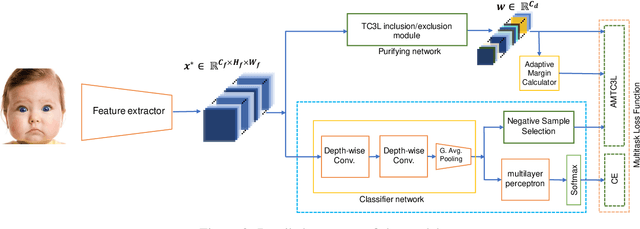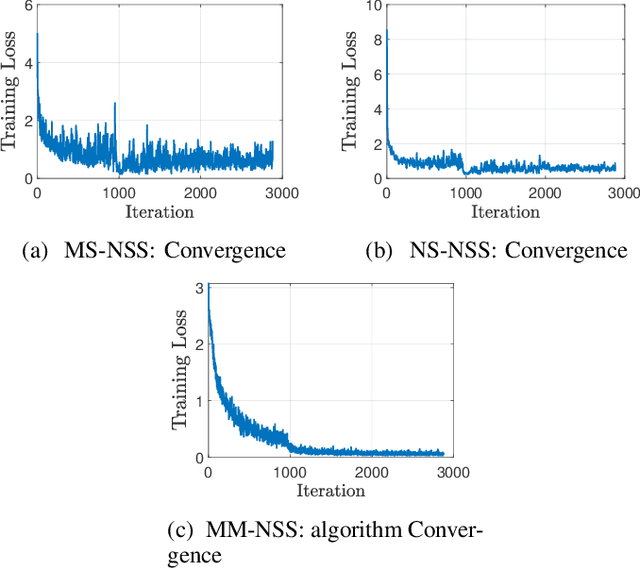Hossein Rajoli
Task Specific Sharpness Aware O-RAN Resource Management using Multi Agent Reinforcement Learning
Nov 19, 2025Abstract:Next-generation networks utilize the Open Radio Access Network (O-RAN) architecture to enable dynamic resource management, facilitated by the RAN Intelligent Controller (RIC). While deep reinforcement learning (DRL) models show promise in optimizing network resources, they often struggle with robustness and generalizability in dynamic environments. This paper introduces a novel resource management approach that enhances the Soft Actor Critic (SAC) algorithm with Sharpness-Aware Minimization (SAM) in a distributed Multi-Agent RL (MARL) framework. Our method introduces an adaptive and selective SAM mechanism, where regularization is explicitly driven by temporal-difference (TD)-error variance, ensuring that only agents facing high environmental complexity are regularized. This targeted strategy reduces unnecessary overhead, improves training stability, and enhances generalization without sacrificing learning efficiency. We further incorporate a dynamic $ρ$ scheduling scheme to refine the exploration-exploitation trade-off across agents. Experimental results show our method significantly outperforms conventional DRL approaches, yielding up to a $22\%$ improvement in resource allocation efficiency and ensuring superior QoS satisfaction across diverse O-RAN slices.
FlameFinder: Illuminating Obscured Fire through Smoke with Attentive Deep Metric Learning
Apr 09, 2024



Abstract:FlameFinder is a deep metric learning (DML) framework designed to accurately detect flames, even when obscured by smoke, using thermal images from firefighter drones during wildfire monitoring. Traditional RGB cameras struggle in such conditions, but thermal cameras can capture smoke-obscured flame features. However, they lack absolute thermal reference points, leading to false positives.To address this issue, FlameFinder utilizes paired thermal-RGB images for training. By learning latent flame features from smoke-free samples, the model becomes less biased towards relative thermal gradients. In testing, it identifies flames in smoky patches by analyzing their equivalent thermal-domain distribution. This method improves performance using both supervised and distance-based clustering metrics.The framework incorporates a flame segmentation method and a DML-aided detection framework. This includes utilizing center loss (CL), triplet center loss (TCL), and triplet cosine center loss (TCCL) to identify optimal cluster representatives for classification. However, the dominance of center loss over the other losses leads to the model missing features sensitive to them. To address this limitation, an attention mechanism is proposed. This mechanism allows for non-uniform feature contribution, amplifying the critical role of cosine and triplet loss in the DML framework. Additionally, it improves interpretability, class discrimination, and decreases intra-class variance. As a result, the proposed model surpasses the baseline by 4.4% in the FLAME2 dataset and 7% in the FLAME3 dataset for unobscured flame detection accuracy. Moreover, it demonstrates enhanced class separation in obscured scenarios compared to VGG19, ResNet18, and three backbone models tailored for flame detection.
Thermal Image Calibration and Correction using Unpaired Cycle-Consistent Adversarial Networks
Jan 21, 2024Abstract:Unmanned aerial vehicles (UAVs) offer a flexible and cost-effective solution for wildfire monitoring. However, their widespread deployment during wildfires has been hindered by a lack of operational guidelines and concerns about potential interference with aircraft systems. Consequently, the progress in developing deep-learning models for wildfire detection and characterization using aerial images is constrained by the limited availability, size, and quality of existing datasets. This paper introduces a solution aimed at enhancing the quality of current aerial wildfire datasets to align with advancements in camera technology. The proposed approach offers a solution to create a comprehensive, standardized large-scale image dataset. This paper presents a pipeline based on CycleGAN to enhance wildfire datasets and a novel fusion method that integrates paired RGB images as attribute conditioning in the generators of both directions, improving the accuracy of the generated images.
Triplet Loss-less Center Loss Sampling Strategies in Facial Expression Recognition Scenarios
Feb 08, 2023



Abstract:Facial expressions convey massive information and play a crucial role in emotional expression. Deep neural network (DNN) accompanied by deep metric learning (DML) techniques boost the discriminative ability of the model in facial expression recognition (FER) applications. DNN, equipped with only classification loss functions such as Cross-Entropy cannot compact intra-class feature variation or separate inter-class feature distance as well as when it gets fortified by a DML supporting loss item. The triplet center loss (TCL) function is applied on all dimensions of the sample's embedding in the embedding space. In our work, we developed three strategies: fully-synthesized, semi-synthesized, and prediction-based negative sample selection strategies. To achieve better results, we introduce a selective attention module that provides a combination of pixel-wise and element-wise attention coefficients using high-semantic deep features of input samples. We evaluated the proposed method on the RAF-DB, a highly imbalanced dataset. The experimental results reveal significant improvements in comparison to the baseline for all three negative sample selection strategies.
 Add to Chrome
Add to Chrome Add to Firefox
Add to Firefox Add to Edge
Add to Edge